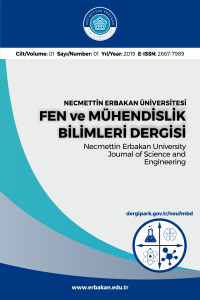Endodontik NiTi Eğelerden Elde Edilen TiO2' nin Boya Duyarlı Güneş Pillerinde Kullanımının Araştırılması
Artan enerji taleplerin karşılanmasında yenilenebilir enerji türleri açısından popüler olan fotovoltaik teknolojiler üzerine verim artırmaya yönelik çalışmalar yapılmaktadır. Boya duyarlı güneş pilleri yüksek altyapı maliyeti gerektirmeyen yapılar olduğundan verim artırmaya yönelik çalışmalar boya duyarlı güneş hücreleri (DSSC) üzerine yoğunlaşmıştır. DSSC’de ışığa duyarlı boya, TiO2 tabakasına tutundurulmaktadır. Kullanım ömrünü tamamlamış NiTi alaşımı endodontik eğeler, farklı asitler üzerinden çözeltiye alınıp metalik değerlerine ayrıştırılmış ve bu metalik değerlerden olan anataz fazında olduğu tespit edilen TiO2 ‘nin boya duyarlı güneş hücrelerinde kullanımına yönelik çalışmalar yapılmıştır. Çalışma kapsamında atık NiTi eğelerden elde edilen kontamine TiO2 ‘nin yapısı karakterize edilmiş ve N719 boya çözeltisinin yüzeye tutundurularak optik özellikleri araştırılmıştır. Boya duyarlı güneş hücrelerinde kullanılan N719 boya çözeltisi uygulanan geri kazanım anataz TiO2 tatbik edilmiş yüzeyle ile görünür bölge spektrumunda belirgin bir etkinlik göstermediği ortaya konulmuştur.
Anahtar Kelimeler:
Boya Duyarlı Güneş Pilleri, Endodontik NiTi Eğe, Titanyum oksit, Anataz, Geri kazanılmış atık malzeme
Investigation of the Use of TiO2 Obtained from Endodontic NiTi Files in Dye-Sensitized Solar Cells
To meet the increasing energy demands, studies are carried out to increase the efficiency of photovoltaic technologies, which are popular in renewable energy types. Since dye-sensitized solar cells do not require high infrastructure costs, studies to increase efficiency have focused on dye-sensitized solar cells (DSSC). In DSSC, the photosensitive dye is attached to the TiO2 layer. Endodontic files of endodontic NiTi alloy, which have completed their service life, were taken into solution over different acids and separated into their metallic values. Studies were carried out using TiO2, which was found to be in the anatase phase, which is one of these metallic values, in dye-sensitized solar cells. Within the scope of the study, the structure of contaminated TiO2 obtained from waste NiTi files was characterized, and its optical properties were investigated by attaching N719 dye solution to the surface. It has been revealed that the N719 dye solution used in dye-sensitized solar cells does not show significant activity in the visible region spectrum with the recovered anatase TiO2 treated surface.
Keywords:
Dye-Sensitized Solar Cells, Endodontic NiTi File, Titanium oxide, Anatase, Recycling waste material,
___
- R.T. Chen, C.F. Liao, Evaluation and optimization to recycle used TiO2 photoelectrode for dye-sensitized solar cells, International Journal of Photoenergy. 2014 (2014). doi:10.1155/2014/650945.
- S. Akin, E. Erol, S. Sonmezoglu, Enhancing the electron transfer and band potential tuning with long-term stability of ZnO based dye-sensitized solar cells by gallium and tellurium as dual-doping, Electrochimica Acta. 225 (2017) 243–254. doi:10.1016/j.electacta.2016.12.122.
- T. Ozturk, B. Gulveren, M. Gulen, E. Akman, S. Sonmezoglu, An insight into titania nanopowders modifying with manganese ions: A promising route for highly efficient and stable photoelectrochemical solar cells, Solar Energy. 157 (2017) 47–57. doi:10.1016/j.solener.2017.08.010.
- J. Wang, Comparison of development prospects between silicon solar cells and perovskite solar cells, Highlights in Science, Engineering and Technology. 27 (2022) 512–518.
- D. Yang, R. Yang, S. Priya, S. Liu, Recent advances in flexible perovskite solar cells: fabrication and applications, Angewandte Chemie International Edition. 58 (2019) 4466–4483.
- H. Tsuji, T. Sagimori, K. Kurita, Y. Gotoh, J. Ishikawa, Surface modification of TiO2 (rutile) by metal negative ion implantation for improving catalytic properties, Surface and Coatings Technology. 158 (2002) 208–213. doi:10.1016/S0257-8972(02)00209-8.
- R. Sastrawan, Photovoltaic Modules of Dye Solar Cells, Albert-Ludwigs University of Freiburg, 2006.
- L. Kavan, M. Grätzel, S.E. Gilbert, C. Klemenz, H.J. Scheel, Electrochemical and photoelectrochemical investigation of single-crystal anatase, Journal of the American Chemical Society. 118 (1996) 6716–6723. doi:10.1021/ja954172l.
- T. Sumita, T. Yamaki, S. Yamamoto, A. Miyashita, Photo-induced surface charge separation of highly oriented TiO 2 anatase and rutile thin films, Applied Surface Science. 200 (2002) 21–26. doi:10.1016/S0169-4332(02)00614-1.
- R.R. Guimarães, A.L.A. Parussulo, H.E. Toma, K. Araki, Enlightening the synergic effect of anatase/rutile mixtures in solar cells, Electrochimica Acta. 188 (2016) 523–528. doi:10.1016/j.electacta.2015.12.040.
- M.İ. Özgün, A. Terlemez, M.E. Acma, Y.R. Eker, A.B. Batibay, Recovering of disposed nickel – Titanium rotary endodontic files via sulfuric acid leaching treatments, El-Cezeri Journal of Science and Engineering. 8 (2021) 1–10. doi:10.31202/ecjse.741512.
- D. Tuschel, Raman spectroscopy and polymorphism, Spectroscopy. 34 (2019) 10–21.
- J. Wang, J. Yu, X. Zhu, X.Z. Kong, Preparation of hollow TiO2 nanoparticles through TiO2 deposition on polystyrene latex particles and characterizations of their structure and photocatalytic activity, Nanoscale Research Letters. 7 (2012) 1–8. doi:10.1186/1556-276X-7-646.
- T. MacÉ, S. Vaslin-Reimann, P. Ausset, M. Maillé, Characterization of manufactured TiO2 nanoparticles, Journal of Physics: Conference Series. 429 (2013). doi:10.1088/1742-6596/429/1/012012.
- J. Jia, L. Mu, Y. Lin, X. Zhou, Electrochimica Acta Rutile versus anatase for quantum dot sensitized solar cell, Electrochimica Acta. 266 (2018) 103–109. doi:10.1016/j.electacta.2018.01.186.
- Yayın Aralığı: Yılda 2 Sayı
- Başlangıç: 2019
- Yayıncı: Necmettin Erbakan Üniversitesi
Sayıdaki Diğer Makaleler
Cebirsel Bir Grafın Harary İndeksi
Muhammed İhsan ÖZGÜN, Ahmet Burçin BATIBAY, Bayram ÜNAL, Yasin Ramazan EKER, Arslan TERLEMEZ
GPS, GLONASS, Galileo ve BeiDou GNSS Sistemlerinin 1. ve 2. Temel Frekanslarının Doluluk Analizi
Sermet ÖĞÜTCÜ, Behlül Numan ÖZDEMİR, Salih ALÇAY, İlkay BUĞDAYCI
Fonksiyonel Derecelendirilmiş Malzeme Plakların Statik Analizinde Mikro-Mekanik Modellerin Katkısı
